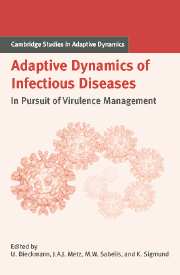Book contents
- Frontmatter
- Contents
- Contributing Authors
- List of Boxes
- Notational Standards
- 1 Introduction
- A Setting the Stage
- B Host Population Structure
- C Within-Host Interactions
- D Pathogen–Host Coevolution
- E Multilevel Selection
- F Vaccines and Drugs
- G Perspectives for Virulence Management
- References
- Index
- International Institute for Applied Systems Analysis
1 - Introduction
Published online by Cambridge University Press: 15 January 2010
- Frontmatter
- Contents
- Contributing Authors
- List of Boxes
- Notational Standards
- 1 Introduction
- A Setting the Stage
- B Host Population Structure
- C Within-Host Interactions
- D Pathogen–Host Coevolution
- E Multilevel Selection
- F Vaccines and Drugs
- G Perspectives for Virulence Management
- References
- Index
- International Institute for Applied Systems Analysis
Summary
Toward the end of the 1960s, by dint of science and collective efforts, humankind had managed to eradicate smallpox and to land on the moon. Accordingly, some of the best-informed experts felt that the time had come to close the book on infectious diseases, and that the colonization of interplanetary space was about to begin. Today, these predictions seem as quaint as the notion – also quite widespread at the time – that the Age of Aquarius was about to begin.
The subsequent decades have taught us to be less sanguine about the future. In 2001 we do not send out manned spacecraft to meet with extraterrestrials, but instead are shutting down obsolete space accommodation. And far from closing the book on infectious diseases, we find that books on infectious diseases still have to be written. Few experts believe, nowadays, that we are witnessing the beginning of the end of our age-old battle against germs. In 1999, for instance, the World Health Organization (WHO) launched an ambitious program, “Roll Back Malaria” – a battle cry that seems tellingly defensive. In the 1960s, optimists still entertained hopes that malaria could be wiped out altogether. And why not? It had worked for smallpox, after all.
Aside from the disappointments with malaria and other infectious diseases – alarming outbreaks of cholera or foot-and-mouth epidemics, for instance – we had to learn to come to terms with other baffling setbacks.
- Type
- Chapter
- Information
- Adaptive Dynamics of Infectious DiseasesIn Pursuit of Virulence Management, pp. 1 - 6Publisher: Cambridge University PressPrint publication year: 2002
- 1
- Cited by



